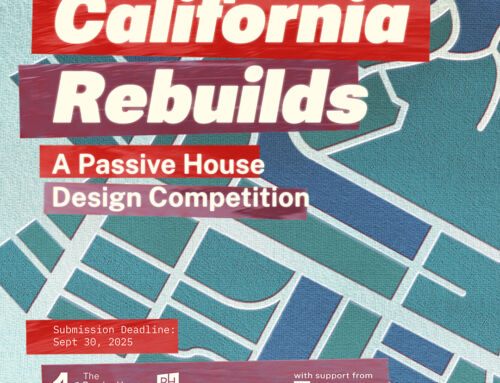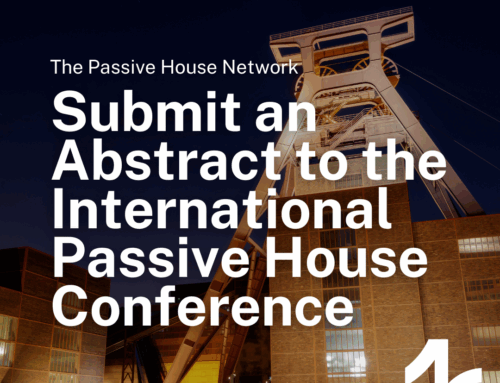Press Release
July 26, 2023
Contact: Peter Jensen, Sunstone Strategies, peter@sunstonestrategies.org, 360.820.3704
Passive House buildings are vital to withstanding the climate crisis and they just hit cost-parity in the U.S. So why are they only 1% of construction?
New report finds well-sealed, highly efficient green buildings can be constructed at similar cost to normal buildings and save on energy costs, but policy changes needed to accelerate nationwide adoption
NEW YORK CITY — With extreme heat, wildfire smoke, and intense storms battering the U.S. this summer, a new report finds that constructing new buildings to all-electric Passive House standards can help protect residents from the devastating impacts of climate change at little to no cost-premium, but policy changes are required to overcome inertia in the building sector and ensure these benefits reach more Americans.
Safe at home: How all-electric, multi-family Passive House buildings deliver comfortable, cost-effective climate resilience, released today by the Passive House Network, provides new cost analysis showing all-electric multi-family Passive House projects can be built at the same cost or close to the same cost as conventionally designed buildings.
“It’s never been more clear that America has two kinds of housing—in buildings that are prepared for climate change, and in buildings that are not,” noted Ken Levenson, Executive Director of the Passive House Network. “And now the data shows that we can build multi-family, all-electric housing that can help residents face the challenges of the 21st Century at the same cost or less than traditional buildings. This is how we build smart, and it should be standard building practice throughout America.”
The report finds that Passive House buildings lower energy usage by up to 80% compared to a standard building at a similar price point. The report includes a survey of 45 multi-family Passive House buildings in New York and Massachusetts in recent years, and finds the average cost to construct a Passive House building to be just 3.7% more than standard, and in some cases cheaper when factoring in incentive programs. By combining incentives from utilities, affordable housing finance programs, and federal tax credits and rebates in the Inflation Reduction Act, many multi-family Passive House buildings can be cheaper to build than standard projects, and IRA incentives that are beginning to roll out in 2023 will decrease costs even more.
Passive House has climate, health, resilience and affordability benefits. Residents of these buildings enjoy heating and cooling bills that are between 30-50% lower than average—and in some cases, these bills are eliminated entirely. In addition to lower energy bills, these pollution-free living spaces are resilient to extreme heat and cold, intense storms, and power blackouts.
But while construction of Passive House buildings has surged since 2018 thanks to growing recognition of and demand for their widespread benefits, Passive House still accounts for less than 1% of all multi-family construction that’s occurred in the U.S. in the past decade. Tellingly, affordable housing has been a significant driver of multi-family Passive House. About half of all Passive House projects being built in the U.S. are affordable housing projects, illustrating the cost-effectiveness of green building design.
“We have the blueprint for coast-to-coast adoption of all-electric, multi-family Passive House buildings,” said Bronwyn Barry, Founding Board Member for the Passive House Network. “Our nation is facing an affordable housing crisis and energy cost crisis, while also confronting severe challenges posed by extreme heat and storms from climate change. Passive House creates more housing, lowers energy costs, and builds resilience against the impacts of climate, while also providing healthier air indoor and out. Everyone should get to experience the comfort – and we have the policy tools and professional know-how to ensure every new multi-family housing project in America is built this way.”
The report finds that construction of all-electric, multi-family Passive House buildings, including market-rate and affordable housing, is primed to soar in early mover states like Pennsylvania, New York, and Massachusetts. This is due to a combination of bold policy requirements in new energy codes as well as utility-funded incentive programs, energy efficiency programs, and the Inflation Reduction Act. More states like Colorado and Maine are following these examples. Half of the states in the U.S. have utility-funded energy efficiency programs, and 13 specifically require programs to invest to support low-income customers or communities of color. These are a fit for supporting all-electric, multi-family Passive House projects.
Another critical benefit of all-electric, multi-family Passive House buildings is how they flatten wintertime energy demand for space heating – which makes them integral to state decarbonization plans. 53% of residential gas consumption in the U.S. occurs in just 11 cold-climate states. In Massachusetts, communities representing 20% of the state’s population, including Boston, have adopted a new specialized energy code that requires large multi-family construction to be Passive House, which has added 10,000 to 20,000 units of Passive House into the construction pipeline. This is a key strategy for speeding up the decommissioning of its aging gas grid, while smoothing the transition to all-electric buildings. Thanks to the expected efficiency gains in buildings, the future peak demand on the power grid is forecasted to increase by a modest 5%. This shows that states that include all-electric, multi-family Passive House in their codes will get better, healthier, pollution-free buildings —and won’t break their grids to electrify.
###




